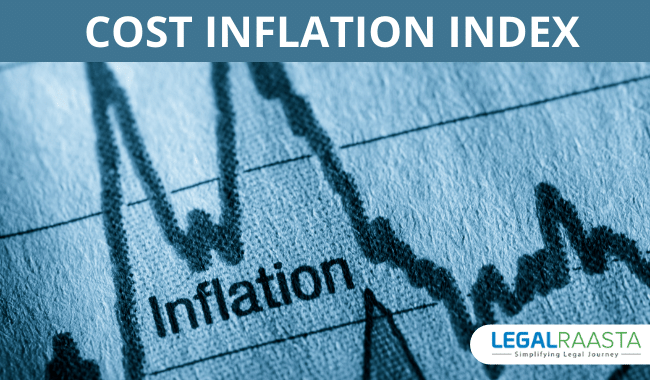Cost Inflation Index
The Central Government fixes the cost inflation index and publishes it in its official gazette for measuring inflation. This index, notified each year by the Government is defined under Section 48 of the Income Tax Act, 1961.
As per section 48(2) of the Income Tax Act “the CII” shall be deemed to be 686 for the assessment year relevant to the previous year when the assessee is an individual, Hindu undivided family, or a firm and shall be deemed to be 835 for any other case.
This index shall be reviewed every five years by the Central Government in consultation with the Council of Boards of Studies, in accountancy.
If this index has not been notified, then section 48(3) of the Act says that “the CII” for any assessment year shall be an amount equal to the percentage increase in the index of industrial production published by the Central Statistical Organization during the immediately preceding financial year.
However, if this index has not been published by the Central Statistics Organization, then section 48(4) of the Act says that “the CII” shall be an amount equal to the percentage increase in the index of the retail price published by the Government during the immediately preceding financial year.
Although section 48(5) of the Act mentions that new cost inflation indexes shall be notified only every five years, this notification has been discontinued since 1988.
The Cost Inflation Index is a reference index used for cost inflation adjustment. It is the mean of the total purchase price and service tax rates on two different items as mentioned in section 48(1-A) of the Income Tax Act. As per rule 2C, an assessee has to calculate and adjust the cost of the production for inflation.
The concept of Cost Inflation Index (CII) was introduced in India by an amendment to Section 50E of the Income Tax Act, 1961 with effect from 10 March 2009. The objective behind the introduction of CII is to protect the benefits of tax deduction at source (TDS) available in respect of investment in listed securities from inflationary erosion.
As per Section 50E, when there occurs a long-term capital gain on transfer of any asset by an assessee who has invested in such asset through a notified intermediary, then the intermediary (i.e. Depository Participant) is required to deduct tax at source @ 10% of the capital gain computed on the amount determined as cost of acquisition plus provisional fair market value on the date of transfer subject to certain exemptions/exclusions provided by section 54, 54B and 54EC of Income Tax Act, 1961.
To calculate the yearly increase in an asset’s price as a result of inflation is defined under section 48(1)of the Income Tax Act 1961. The Cost Inflation Index is one way to measure this, another being Consumer Price Index (CPI). While CII is calculated using actual sale prices of goods or services in the market, CPI is calculated using hypothetical estimates. CII measures the impact of price changes on business expenses whereas CPI measures how much additional money you would need to purchase the same quantity with regard to an item that was purchased earlier. It is important to note that when calculating inflation for tax purposes, one cannot use the CPI index.
As per rule 2B, the production cost is calculated by adding all expenses incurred to produce a good or service and subtracting the amount earned from it.
The Central Government has fixed the Cost Inflation Index for different financial years in its official gazette, containing a list of notification/notifications issued by it from time to time. As per section 48(1)of the Income Tax Act, the Central Government issues notification/notification every year after considering the recommendations of the Council for Boards of Studies in Accountancy.
Under sub-section (4), if no CII is notified by the central government under subsection (1) or subsection (2), then under sub-section (3) “the cost inflation index” meaning the cost inflation index for the year concerned, shall, if no notification has been issued under sub-section (1) or sub-section (2), be deemed to be 14% for the assessment year relevant to the previous years in which “the CII” is not notified.
Introduction:
The Cost Inflation Index (CII) is a price index that measures the cost of capital assets in terms of their replacement costs. The CII, when multiplied with the Market Value of Capital Assets (MVCA), gives the new replacement cost of the asset.
Assets are classified into three categories for this purpose: (i) capital assets; (ii) short-term assets; and (iii) long-term assets.
For the purposes of inflation indexing, assets are also classified into two classes: (i) assets that are held by the assessee for more than three years; and (ii) assets that are held by the assessee for three years or less.
Cost inflation index applicable to a capital asset other than derivative contracts entered into by the taxpayer to hedge against the price risk in respect of any asset or liability including interest or dividend.
A Cost Inflation Index table is used to calculate the long-term capital gains from a transfer or sale of capital assets. Capital gain refers to the profit acquired from the sale/transfer of any capital assets, including land, property, stocks, shares, trademarks, patents, etc. The government taxes such activity through Income Tax and Wealth Tax Acts. The IT Act, 1961 prescribes that income from capital assets should be taxed at the time of sale/transfer of the asset. Wealth tax is only imposed on fixed assets like land and property
In accounting, usually, long-term capital assets are recorded at their cost price in books. Thus, despite rising prices of assets, these capital assets cannot be revalued. Thus, at the time of sale of these assets, the profit or gain acquired from them remains high due to their high sale price in comparison to their purchase price.
Thus, the government introduced a Cost Inflation Index (CII), which is used to identify and record such costs to calculate capital gains tax. The CII is a price index that measures the cost of capital assets in terms of their replacement costs. The CII, when multiplied with the Market Value of Capital Assets (MVCA), gives the new replacement cost of the asset.
This index is used to adjust the purchase price of assets according to their sale price, leading to lower profits and lower tax amounts on them.
At present, the Cost Inflation Index (CII) is usually computed by using two indices – Wholesale Price Index (WPI) and Consumer Price Index (CPI).
The Central Board of Direct Taxes has the power to determine the CII every year. As per Section 48(1) of Income Tax Act, 1961, the Central Government may specify by notification in the official gazette, either generally or for any specified class or classes of cases, income arising to any person carrying on any business or profession shall be computed by such officer, authority or person as the Board may designate, in accordance with such procedure as may be prescribed
Benefits of using the CII
1) Presently, there is no statutory provision for recording long-term capital gain arising out of transfer/sale of capital assets, whereas the IT Act 1961 prescribes that income from capital assets should be taxed at the time of sale/transfer of the asset.
2) The CII facilitates in computing capital gains on assets that are initially acquired at different periods and revalued periodically (Capital Assets that are revalued periodically, like properties). If the cost price is not maintained for such assets that are revalued periodically, there is a risk of understating long-term capital gains. Thus, the CII facilitates in computing the cost price of such assets for taxation purposes.
3) The same result cannot always be achieved by using different methods as those may have varying results due to differences in analysis and data provided. Thus, the cost inflation index method provides a fair standard method of determining the cost price of capital assets, without being biased towards any particular party.
4) Since the CII is a statistical approach to determine the cost price of the capital asset, it provides a fair and equitable result as it does not favor any person/organization/group/class of people. It also removes any personal interpretation of the data.
5) The CII provides a simplified method to determine long-term capital gains arising out of transfer/sale of capital assets, which will be beneficial to taxpayers as well as tax officials.
6) The CII facilitates in computing the amount of depreciation on capital assets for taxation purposes by using revaluation price instead of historical cost.
7)The CII provides a uniform method for determining capital gains/losses due which is beneficial to tax officials and taxpayers.
Disadvantages of using the CII
1) There can be significant understating of income due to inaccurate determination of long-term capital gain on transfer/sale of capital assets since the CII is a statistical method and it does not provide any legal backing to determine the cost price of capital assets.
2) There can be a significant overstatement of income due to inaccurate determination of long-term capital gain on transfer/sale of capital assets since there is no provision for revisiting the CII from time to time.
3) The CII may lead to inflated capital gains due to its inflationary operation since it is not related to any current index. An arbitrary CII is normally used, which may lead to an overstatement of income.
Thus, considering all the pros and cons of using the CII, it has been decided by the Income Tax Department that the cost inflation index (CII) as notified
Illustration
Therefore, in this case, the purchase price of Rs 5 crore is not equal to the selling price of Rs 9 crore. To determine the correct value, we have to factor in inflation.
Thus, the inflation factor in this case is
Cost Inflation Index = (9/5) × 105.2
This can be verified from a Cost Inflation Index table, which you would have to use alongside your computation sheet when working out long-term capital gains from a transfer or sale of capital assets. As a result, in this case, the capital gain arises from Rs 2 crore to Rs 5.33 crore (Rs 9 crores minus Rs 3.67 crores).
In this example, we have assumed that inflation is constant throughout the ten-year period. In reality, during 2005-06 and 2015-16, there was a decrease in inflation between the two years. The prices of goods and services went down, although this reduction was not uniform across all commodities.
You can use the data from the Cost Inflation Index published by the Central Statistical Organisation (CSO) to prepare charts that will give you real-time information about inflation over the last few years.
Conclusion:
A Cost Inflation Index table is used to calculate the long-term capital gains from a transfer or sale of capital assets. Capital gain refers to the profit acquired from the sale/transfer of any capital assets, including land, property, stocks, shares, trademarks, patents, etc. The CII facilitates in computing capital gains on assets that are initially acquired at different periods and revalued periodically. If the cost price is not maintained for such assets that are revalued periodically, there is a risk of understating long-term capital gains. Thus, the CII facilitates in computing the cost price of such assets for taxation purposes. The same result cannot always be achieved by using different methods as those may have varying results due to differences in analysis and data provided. Thus, the cost inflation index method provides a fair standard method of determining the cost price of capital assets, without being biased towards any particular party. Since the CII is a statistical approach to determine the cost price of the capital asset, it provides a fair and equitable result as it does not favor any person/organization/group/class of people. It also removes any personal interpretation of the data. The CII provides a simplified method to determine long-term capital gains arising out of the transfer/sale of capital assets, which will be beneficial to taxpayers as well as tax officials. The CII facilitates in computing the amount of depreciation on capital assets for taxation purposes by using revaluation price instead of historical cost. The CII provides a uniform method for determining capital gains/losses due which is beneficial to tax officials and taxpayers.










